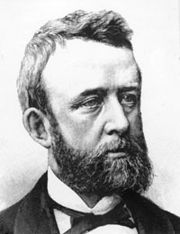
Axel Gudbrand Blytt
Encyclopedia

Norway
Norway , officially the Kingdom of Norway, is a Nordic unitary constitutional monarchy whose territory comprises the western portion of the Scandinavian Peninsula, Jan Mayen, and the Arctic archipelago of Svalbard and Bouvet Island. Norway has a total area of and a population of about 4.9 million...
botanist and geologist. His father was Matthias Numsen Blytt, also a botanist. Axel Blytt served at the Christiania Herbarium at the University of Oslo
University of Oslo
The University of Oslo , formerly The Royal Frederick University , is the oldest and largest university in Norway, situated in the Norwegian capital of Oslo. The university was founded in 1811 and was modelled after the recently established University of Berlin...
from 1865, first as a conservator, then, from 1880, as a professor. Based partly on his father's work, he published in the 1870s the book Essay on the Immigration of the Norwegian Flora during Alternating Rainy and Dry Periods. He is today best known for developing the Blytt-Sernander
Blytt-Sernander
The Blytt-Sernander classification, or sequence, is a series of north European climatic periods or phases based on the study of Danish peat bogs by Axel Blytt and Rutger Sernander...
theory of climatic change. His work, Essay on the Immigration of Norwegian Flora. (1876) was read by, and influenced, Charles Darwin
Charles Darwin
Charles Robert Darwin FRS was an English naturalist. He established that all species of life have descended over time from common ancestry, and proposed the scientific theory that this branching pattern of evolution resulted from a process that he called natural selection.He published his theory...
.
Blyttberget, a high crag
Cliff
In geography and geology, a cliff is a significant vertical, or near vertical, rock exposure. Cliffs are formed as erosion landforms due to the processes of erosion and weathering that produce them. Cliffs are common on coasts, in mountainous areas, escarpments and along rivers. Cliffs are usually...
southeast of Nordlaguna on the Norwegian island of Jan Mayen
Jan Mayen
Jan Mayen Island is a volcanic island in the Arctic Ocean and part of the Kingdom of Norway. It is long and 373 km2 in area, partly covered by glaciers . It has two parts: larger northeast Nord-Jan and smaller Sør-Jan, linked by an isthmus wide...
, is named for him. The German botanist Wilhelm Schimper
Wilhelm Schimper
Georg Heinrich Wilhelm Schimper was a German botanist and naturalist born in Reichenschwand. He was a brother to naturalist Karl Friedrich Schimper....
named several mosses after him as well.
The remaining existent specimens Blytt collected on his studies are held at the Botanical Museum of the University of Oslo
University of Oslo
The University of Oslo , formerly The Royal Frederick University , is the oldest and largest university in Norway, situated in the Norwegian capital of Oslo. The university was founded in 1811 and was modelled after the recently established University of Berlin...
. The Buffalo Museum of Science
Buffalo Museum of Science
Buffalo Museum of Science is a science museum located at Martin Luther King, Jr. Park in Buffalo, New York USA, northeast of the downtown district, near the Kensington Expressway. The historic building was designed by August Esenwein and James A. Johnson and opened in 1929...
in Buffalo, New York
Buffalo, New York
Buffalo is the second most populous city in the state of New York, after New York City. Located in Western New York on the eastern shores of Lake Erie and at the head of the Niagara River across from Fort Erie, Ontario, Buffalo is the seat of Erie County and the principal city of the...
also holds a collection of specimens attributed to a collector identified as "Blytt", who is likely Axel Blytt. This is evidenced by Charles Peck
Charles Horton Peck
Charles Horton Peck, born March 30, 1833 in Sand Lake, New York, died 1917 in Albany, New York, was an American mycologist of the 19th and early 20th centuries...
, the New York State Botanist from 1883 to 1913, in his 1872 Report of the Botanist to the New York Senate. Peck wrote that he had received 22 specimens of lichens from the University of Norway, Christiana (Oslo), Norway, for the New York State Cabinet. There is also a mention of Blytt in correspondence between the Swiss botanist Leo Lesquereux
Leo Lesquereux
Charles Léo Lesquereux was a Swiss bryologist and a pioneer of American paleobotany. He was born in the town of Fleurier, located in the canton of Neuchâtel....
and George William Clinton, then President of the Buffalo Museum of Natural Sciences, regarding specimens and a visit to the Buffalo Museum by Lesquereux. Though the existing correspondence only provides Lesquereux's letters, he refers to Blytt as "a good Norwegian Botanist I do not know his address in any other way than as you write it. Christiania Norway."

